Introduction and Summary
Bill Bradley is the man in the middle when it comes to voter perceptions. Americans describe the former New Jersey senator as a political moderate far more frequently than they do any other presidential candidate. On average, voters who know Bradley rate his ideology as virtually identical to their own. But, despite the increased media attention given to his candidacy, four-in-ten voters have not heard of Bradley, and his level of national support remains unchanged since February.
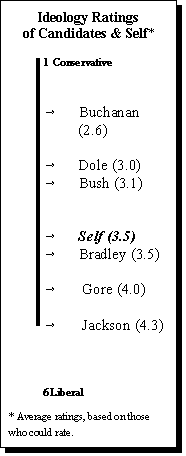 With his middle-of-the-road image, Bradley is better positioned for the November election than for the Democratic primaries. In general, Democrats see themselves as more liberal and ideologically closer to Vice President Al Gore than to Bradley. Democrats view the former New Jersey senator more as a moderate, and his constituency reflects this. For example, on gun control, Bradley supporters, like Americans overall, narrowly divide against an all-out ban on handguns, while Gore voters and a majority of Democrats back a ban.
With his middle-of-the-road image, Bradley is better positioned for the November election than for the Democratic primaries. In general, Democrats see themselves as more liberal and ideologically closer to Vice President Al Gore than to Bradley. Democrats view the former New Jersey senator more as a moderate, and his constituency reflects this. For example, on gun control, Bradley supporters, like Americans overall, narrowly divide against an all-out ban on handguns, while Gore voters and a majority of Democrats back a ban.
The Republican frontrunners stand as much to Bradley’s right as Gore does to his left, in the eyes of the public. Americans perceive Texas Governor George W. Bush and former Red Cross President Elizabeth Dole as more conservative than they see themselves, but more moderate than Patrick Buchanan, who ran unsuccessfully for the GOP nomination in 1996. On an ideological scale, Republicans place themselves right alongside Bush and Dole.
In addition to gun control, the Pew Research Center survey of 1,179 adults, conducted May 12-16, 1999, also looked at many of the family and community issues that have gained attention in the wake of the Littleton High School shootings. Traffic ranks as the top community concern of Republicans, while the lack of recreational programs for teens is the top concern for Democrats. Democrats also express more concern than Republicans about overcrowded classrooms in school.
Voters Unchanged
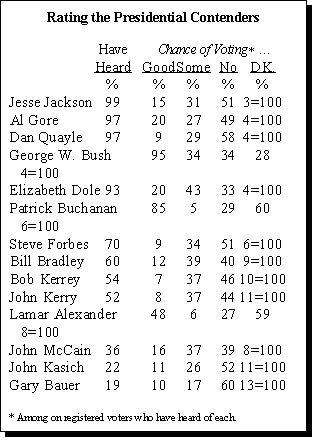 Bradley faces a recognition problem far greater than that of any other leading presidential candidate. Only 60% of voters say they have heard of Bradley, up from 55% in February. Among those who have heard of the candidate, 51% say there is at least some chance they would vote for him, compared to 55% three months ago. Indeed, 44% of Americans say they don’t know enough about the former NBA star to place him on a six-point liberal to conservative scale.
Bradley faces a recognition problem far greater than that of any other leading presidential candidate. Only 60% of voters say they have heard of Bradley, up from 55% in February. Among those who have heard of the candidate, 51% say there is at least some chance they would vote for him, compared to 55% three months ago. Indeed, 44% of Americans say they don’t know enough about the former NBA star to place him on a six-point liberal to conservative scale.
Bradley is not alone in his static numbers. There has been little change since February in the number of voters who say there is at least some chance they would vote for Gore, Bush and Dole. Roughly two-thirds of voters say they would consider voting for Bush and Dole, 68% and 63%, respectively. Slightly less than half (47%) say they would consider voting for Gore. Support for these candidates has not risen or fallen substantially since February.
Other well-known candidates continue to draw little support. For example, just 38% of voters say they would consider voting for Dan Quayle, while 58% say there is no chance they would support the former vice president.
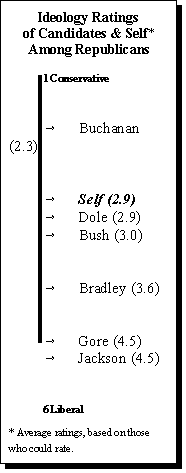
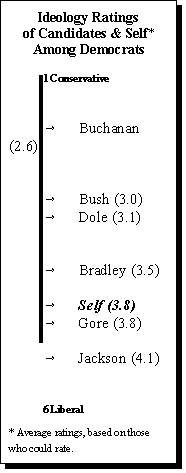 Among people who can rate the candidates, new faces like Bradley, Bush and Dole are seen as more moderate — and more like the average rating Americans give themselves– than familiar faces like Jesse Jackson and Patrick Buchanan. A 57% majority rates Bradley as a moderate, for example, while more than 40% give similar ratings to Bush and Dole. In contrast, 36% rate Gore as a moderate and even fewer give centrist ratings to Buchanan or Jackson. Half of Americans (50%) place themselves in the middle, while 25% rate themselves as conservative and 25% as liberal.
Among people who can rate the candidates, new faces like Bradley, Bush and Dole are seen as more moderate — and more like the average rating Americans give themselves– than familiar faces like Jesse Jackson and Patrick Buchanan. A 57% majority rates Bradley as a moderate, for example, while more than 40% give similar ratings to Bush and Dole. In contrast, 36% rate Gore as a moderate and even fewer give centrist ratings to Buchanan or Jackson. Half of Americans (50%) place themselves in the middle, while 25% rate themselves as conservative and 25% as liberal.
Democrats see themselves and their party’s leading figures as just to the left of center. On a six-point, liberal-to-conservative scale, Gore comes closest to the way average Democrats describe themselves, with Bradley just to his right and Jackson to his left. Republicans meanwhile see little difference between themselves and the leading GOP presidential candidates Bush and Dole on this ideological scale. Buchanan is seen as somewhat more conservative.
Gun Control
Given a choice between protecting the rights of gun owners and controlling gun ownership, two-thirds of Americans now favor restrictions on ownership of fire arms. At 65%, the percentage holding this view has climbed eight percentage points since late 1993.
Almost all demographic groups show increased support for gun control, with shifts of more than 10 percentage points among people over age 65, those with some college education and women. An overwhelming 75% of women now favor restricting fire arm ownership, compared to just 19% of women who place a greater priority on the rights of gun owners. Men are more evenly divided: 53% prefer restrictions; 42% protecting the right to bear arms. Three-quarters (76%) of Democrats say gun control is more important than the right to ownership, compared to 53% of Republicans.
Despite this growing support for gun control generally, Americans are no more supportive of a law banning handguns outright than they were in 1993. A bare 50% majority continues to oppose such a law; 44% say they would support it. But on this narrowly-divided question, men and women hold opposite views, as do Democrats and Republicans. Women split 55%-38% in favor of a handgun ban; Democrats 54%-40%. Men divide 63%-33% against it; Republicans 60%-35%.
Television Violence
Nearly two-thirds (63%) of Americans now say that television news is too full of violence. Six years ago, barely half (52%) of the public felt this way. Fully 70% of the public also says entertainment television contains too much violence, a number that has been roughly stable since as far back as 1971. On both of these questions, more women than men say there is too much violence on television, with 77% of women and 63% of men saying this of entertainment TV.
 Nearly all Americans (89%) say they are personally concerned about what children see or hear on television; 64% are very concerned. The same number (64%) are very concerned about what children are exposed to on the Internet, with just slightly fewer saying the same of movies (60%) and video games (57%). On this question, parents of children under age 18 are slightly more concerned than others about each electronic medium. The difference is most pronounced for the Internet: 73% of parents say they are very concerned, compared to 58% of non-parents.
Nearly all Americans (89%) say they are personally concerned about what children see or hear on television; 64% are very concerned. The same number (64%) are very concerned about what children are exposed to on the Internet, with just slightly fewer saying the same of movies (60%) and video games (57%). On this question, parents of children under age 18 are slightly more concerned than others about each electronic medium. The difference is most pronounced for the Internet: 73% of parents say they are very concerned, compared to 58% of non-parents.
When asked to rank their concerns, Americans put television and the Internet on top, with 39% and 36%, respectively, saying they are most concerned about what children see and hear there; 14% say this of video games and 7% of movies.
Community Matters
Overall, Americans are increasingly satisfied with where they live: 66% say their community is an excellent or very good place to live, up from 56% in February 1997. More than one-in-three (35%) say that people like themselves can have a big impact on making their community a better place to live, an increase from 25% in February 1997.
No community problem is viewed as very serious by more than a quarter of the public. The lack of recreational programs for teenagers ranks as the chief community concern today — 25% of the public says it’s a very serious problem — followed closely by traffic (20%) and overcrowded classrooms (19%).
For all the attention given to suburban issues recently, fewer than one-in-five suburbanites expresses very serious concern about any issue other than traffic and crowded classrooms. Suburbanites also express less concern about the lack of teen programs than do urban, small town and rural Americans.
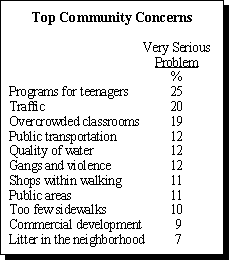 A shortage of teen activities is a particular worry for parents of minors, 32% of whom cite the issue as a very serious problem. The issue tops the list for people living in small towns and rural areas: 29% and 24%, respectively, say it is a very serious problem. A similar number of urban dwellers (27%) see the lack of teen programs as a very serious problem. Just 15% of suburbanites say it is a very serious problem where they live.
A shortage of teen activities is a particular worry for parents of minors, 32% of whom cite the issue as a very serious problem. The issue tops the list for people living in small towns and rural areas: 29% and 24%, respectively, say it is a very serious problem. A similar number of urban dwellers (27%) see the lack of teen programs as a very serious problem. Just 15% of suburbanites say it is a very serious problem where they live.
Traffic is most often cited as a very serious problem by both urban and suburban residents: 39% and 24%, respectively. The issue is of relatively little concern to those in rural communities and small towns: 11% and 15%, respectively.
Overcrowded classrooms and gangs are also a major problem for one-third of those living in large cities; 33% and 29%, respectively, rank these concerns as very serious. Only 19% of those in the suburbs and 14% in small cities and rural areas identify crowded classrooms as a very serious problem, and fewer than 10% say this is so of gangs and violence.
Other issues, including public transportation, quality of tap water, availability of public spaces, and too few sidewalks, are considered to be very serious problems by less than 15% of Americans. Fewer than one-in-ten say that commercial development and neighborhood litter are major problems.
African American Communities
More African Americans than whites identify specific community issues as serious problems in their neighborhood. The racial differences are especially stark on the lack of recreational activities for teenagers (46% of African Americans say it is a very serious problem, compared to 22% of whites) and overcrowded schools (36% of blacks, compared to 16% of whites). Reflecting this broad dissatisfaction, fewer African Americans say that their community is an excellent place to live (8%) than do white Americans (31%).
Despite these findings, African Americans are at least as likely to say that people like themselves can have a positive impact on their community (38% vs.34%, respectively).
Democrats and Republicans rank these problems somewhat differently. For instance, among Republicans, traffic problems rank as the most serious community concern — 24% say it is a very serious problem. Not having enough recreational programs for teenagers is identified as the most serious community problem among Democrats (29%) and Independents (26%).
Organ Donation Incentives?
 Only a slim majority of the public (53%) says that offering financial incentives for organ donations, such providing $300 for the donors’ funeral expenses, is a good idea.
Only a slim majority of the public (53%) says that offering financial incentives for organ donations, such providing $300 for the donors’ funeral expenses, is a good idea.
These reservations are expressed despite the fact that 74% of Americans say that the long wait for seriously ill people to receive organ transplants is a major problem, and 81% support the concept of organ donation.
Less than half (42%) of Americans say that they have granted permission to donate their organs on a driver’s license or a signed donor card, although 67% indicate they are at least somewhat likely to donate after death.
Better educated people are more likely to have granted permission to donate their organs at death than are those lacking college degrees, 58% and 37%, respectively. But college graduates are less supportive than others of paying people to donate organs (49% compared 54%). Similarly, among those with annual family incomes of less than $50,000, 61% think that paying for organ donations is a good idea, compared to only 48% of wealthier Americans.


